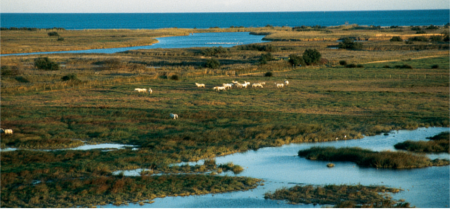Parc Natural dels Aiguamolls de l’Empordà
Description
The Aiguamolls de l’Empordà Natural Park is the second most important wetland area in Catalonia, after the Delta del Ebro.
In the past these marshes covered the whole area of the plains of the Roses bay and the Baix Ter, so that the Montgrí massif, between l’Escala and Torroella -delimiting the Alt and Baix Empordà-, stood out like an island in the middle of the waters.
Until the seventies of the last century, the marshes had deteriorated considerably: the wetland areas of the Ampordà were disappearing due to the over urbanisation and creation of all sorts of tourism facilities. Therefore, in 1976 a popular campaign was started that, under the slogan of "Els últims Aiguamolls de l’Empordà, en perill", fought to recover these areas. There was such popular pressure that on 28 October 1985 the Generalitat de Catalunya declared it an Area of National Interest, and a year and a half later, on 13 June 1985, declared it a Natural Park.
A large part of the protected area corresponds to the district of Castelló d’Empúries, but the park also covers Palau-saverdera, Pau and Peralada, among other municipalities. The park has three nature reserves: the island of Caramany, the Llaunes (coastal saltwater lagoons) and the Estanques (among which is that of Vilaüt) and a partial area. In total it covers 4,866 hectares. To the north it is delimited by the Muga and to the south by the Fluvià.
The park is inhabited by varied flora and fauna. Most notable are the tamarinds (shrubs capable of living on salty land), the marine rush, reeds and salicornia.
With regard to the fauna, a large number of reptiles (toad-headed turtle, three-toed skink, water snake), amphibians (various frogs, marbled newt), fish and mammals (rabbit, weasel, badger, fallow deer). There are also the omnipresent insects and the most emblematic animals of wetland areas, birds, both those that inhabit the area all year round as well as those that are there for a time, on the path south, at the end of the summer or north, in spring.
Therefore, visitors can easily identify various species of duck, heron, egrets and cattle egrets, and see the harriers glide and the cormorant dry off its plumage and admire the elegance of the long-legged birds, such as cranes, flamencos, sandpipers and the conspicuous storks, reintroduced in the park in the eighties. The human effort to recover the last Aiguamolls of l’Empordà has also led to the successful reintroduction of other species, such as the purple swamphen and the otter.
From the office in El Cortalet, on the Sant Pere Pescador to Castelló d’Empúries road, various activities and guided tours can be signed up for, to discover the marshes. Information can also be obtained in the tourist offices of the local towns (L’Escala, Peralada, Figueres, Roses…).
Contact











